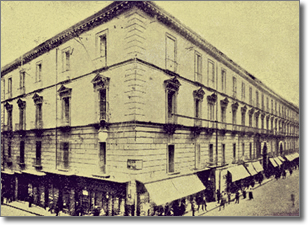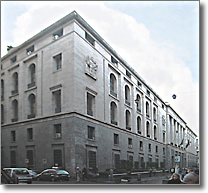
- Façade of Palazzo San Giacomo in Via Toledo at the corner of Via San Giacomo about 1900

For the Neapolitans of the time of Matilde Serao, Salvatore Di Giacomo, and Ferdinando Russo it was enough to say "sotto 'è Finanze" (just by the Finanze building) to indicate a precise place. The expression had become "metabolized" and had no need of the frills of an address: quarter, palazzo, street number. It was like saying "sotto 'o San Carlo" (just by San Carlo Opera House), "a San Ferdinando", "in Galleria" - that was enough.
"Sotto 'e Finanze" was the pavement of Via Toledo where the upper side of Palazzo San Giacomo stood, that huge building that had contained the Ministries of State and the Bank and the financial offices of the Kingdom of the Two Sicilies.
This side of San Giacomo was stylistically similar to the othr which overlooked the piazza, but was a storey lower and had one portal fewer; it overlooked the street which Stendhal described as "the most crowded and cheerful in the world". Along the façade were the windows of many shops: "I ricami di Napoli" (Naples embroidery), the jeweller's "Cinque e De Simone", the shoe-shop "Radice", the perfume shop"Arène", the "Jolanda" bar, which were just a few of them.
Between the shop windows was the other main doorway, the one on the right, the window-paned corridor/passage way whicih led straight to Piazza del Municipio. Here, as the chronicles of the time tell us, there was a woman selling letter-paper and postcards, selling her wares by calling out the incessant refrain: ""carta-tela, tela carta; e so' sempe carte, ccà niusciuno vo fa carte; ce vonno 'e carte 'e mille lire pe fa carte, carta-tela;tela-carta" (paper-cloth, cloth paper; whatever, it's always paper, no one here wants to do anything, you need paper and a thousand lire to get something done, paper-cloth; cloth paper).

That was what it was like up to the end of the thirties of the last century. Then, with the approach of the fourth centenary of the foundation of the Banco di Napoli, which had eveolved from the Bank of the Two Sicilies, it was decided to transform and make independent that part of Palazzo San Giacomo where the bank was located.
Since 1939, making an appointment "sotto 'e Finanze" has had no meaning; with the transformation of the façade the soul of the place disappeared, which is what the expression referred to.
And perhaps the letter-paper seller returned to her previous place of work and thought, feeling quite lost: "no one wants to get anything done here". Without looking back, she must have left, this time for ever, her too.
Area Cultura e Turismo Servizio Beni Culturali - Archivio Storico Municipale
Salita Pontenuovo, 31 - 80139 Napoli
e-mail: archivi.storici.biblioteche@comune.napoli.it
pec: archivi.biblioteche@pec.comune.napoli.it
Accetto la cookie policyContinuando ad utilizzare questo sito l'utente acconsente all'utilizzo dei cookie sul browser come descritto nella nostra cookie policy, a meno che non siano stati disattivati. È possibile modificare le impostazioni dei cookie nelle impostazioni del browser, ma parti del sito potrebbero non funzionare correttamente. visualizza la cookie policy
Accept